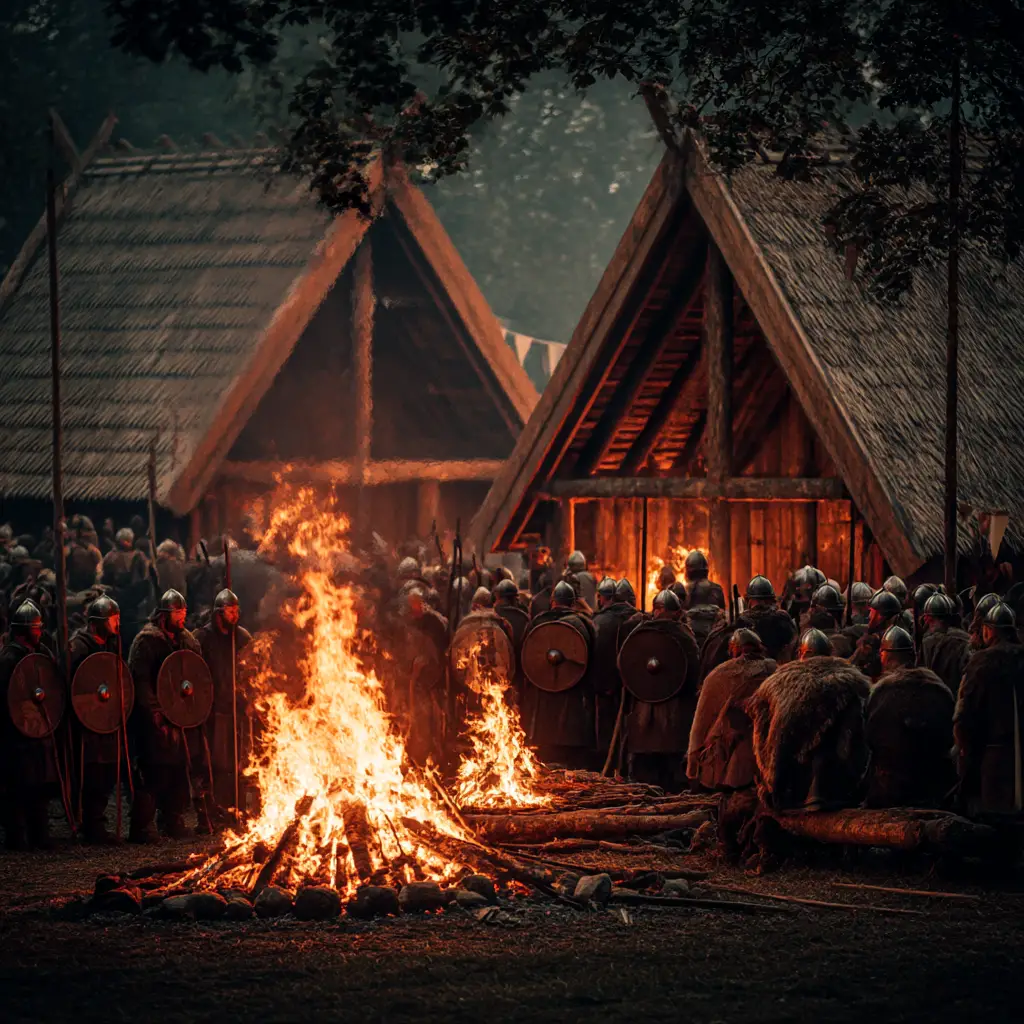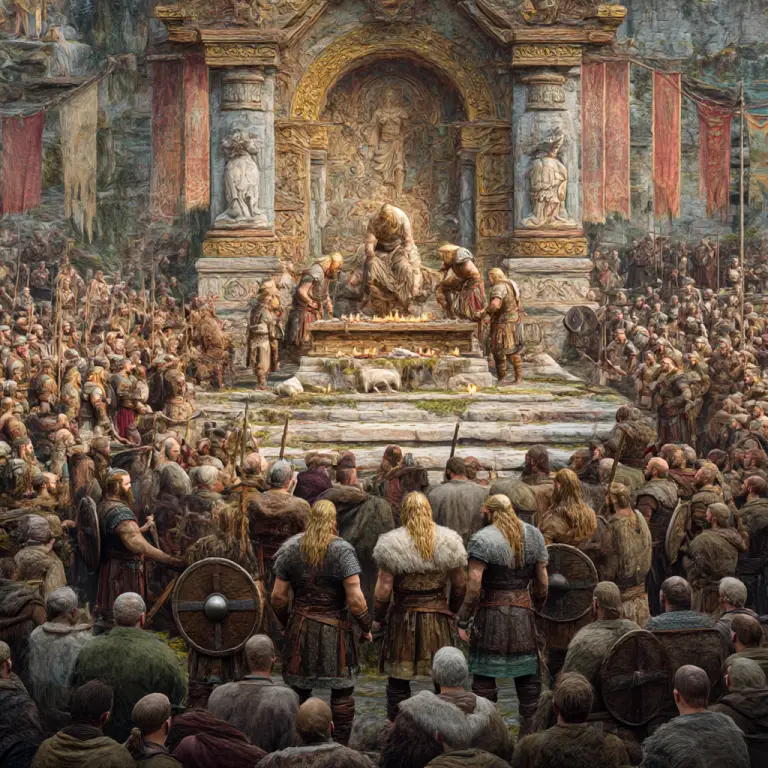Here is a full-length website-style article in UK English about the festival known as Sigrblot. If you meant a modern event with the same name rather than the historical Norse festival, I can adapt it accordingly — just let me know.
Sigrblot — literally “victory-sacrifice” (Old Norse sigr = victory, blót = sacrificial feast) — was a major ceremonial festival in early medieval Norse culture. dormancy into spring initiative, and the launch of both agricultural and martial campaigns for the Norse peoples.
The festival was deeply embedded in religious, social and political life, reflecting how intertwined ritual, communal identity and practical concerns (such as raiding, farming or sea-voyaging) were in Viking-age society.
Historical Context & Origins
Sigrblot draws its roots from pre-Christian Germanic ritual traditions that celebrated the end of winter and the return of productive seasons.
Over time, as Norse society evolved (from small clan units toward larger chieftain-led or royal structures), the festival grew in significance and scale.
It appears in sources such as the Icelandic sagas and historical texts—often filtered through Christian perspectives—so while the exact details are partly speculative, scholars agree on its broad functions and timing.
Timing and Annual Cycle
Sigrblot was typically celebrated in spring, roughly aligning with the transition from winter to summer (for example around or soon after the spring equinox).
The timing was purposeful: agricultural work (ploughing, sowing) became feasible, and the calmer seasons opened the possibility of voyages and raids. The festival thus symbolised renewal, growth and outward movement.
Unlike festivals devoted solely to harvest or hearth, Sigrblot had a more outward-oriented dimension — preparing for expedition, conflict and communal enterprise.
Religious Aspect
At the heart of Sigrblot were sacrificial rituals (blót) offered to the Norse gods — particularly Odin, the god of battle, wisdom and death — and also to deities of fertility and prosperity such as Freyr and Freyja.
Sacrifice could take many forms: animals (commonly horses, oxen or other livestock), offerings of food, drink (notably mead), valuables or symbolic items. The act of sacrifice was understood as forging a link between human community and divine favour.
The communal feast that followed—consuming the consecrated meat and drink—served both as a sacred act and a social one: participants received the gods’ blessing and affirmed social bonds.
Social & Political Dimension
Sigrblot was a major gathering for the community—chieftains, jarls, warriors, farmers, priests and free men. The festival provided a forum for alliances, oaths, dispute resolution and planning of military ventures or expeditions.
Leaders used the occasion to display generosity (hosting feasts, distributing gifts), thereby solidifying loyalty and status. The sacrificial ritual underscored their role as mediators between the human and divine realms.
Because the festival marked a turning point (from winter to action), it became embedded in the ideology of expansion, travel, raiding and settlement. The community mentally and materially prepared for the year ahead.
Rituals and Ceremonies
Some of the key practices associated with Sigrblot include:
- A procession by the participants to the sacrificial site (which might be a grove, temple, altar or sacred place) to mark the beginning of the ritual.
- Purification rites for both place and people before the sacrifice proper.
- The main sacrifice: selection and slaughter of an animal (often a horse or ox), the sprinkling of blood or its symbolic appropriation, and the offering of meat and drink to the gods.
- The communal feast (blót feast) where participants ate the offerings, drank mead, perhaps made toasts to the gods, and participated in storytelling, music, dance or reciting sagas.
- The use of runes, sacred trees, carved images or altars as symbolic mediums in the ritual: for example runic inscriptions, sacred objects, or the placing of offerings at altars or in water
These rituals were not only religious but also social: they reinforced community identity, hierarchical relationships and collective preparation for the coming season.
Thematic Focus: Victory, Renewal and Journey
The term “victory” in the festival’s name emphasises that this was not just a harvest or fertility festival; it was oriented toward success in ventures—be they raiding, trading, colonising or farming.
At the same time, by being placed at the threshold of outward movement (the spring voyages, raids), the festival symbolised renewal—not merely of crops but of enterprise, mobility and community endeavour.
The intersection of agricultural, martial and seafaring concerns is evident—fields needed sowing, ships needed crews, communities needed fortunes, and the gods needed appeasement.
Legacy and Modern Interpretations
With the Christianisation of the Norse lands (from around the 10th century onward) many of the old pagan rituals were suppressed or transformed. The festival of Sigrblot likely declined or merged into other Christian-feast practices.
Nevertheless its legacy survives in:
- Modern interest in Norse culture, Viking festivals and historical reenactment.
- Occasional adoption within neo-pagan, heathen or reconstructionist spiritual groups who seek to revive or reinterpret the old rituals.
- Popular culture representations (novels, games, movies) that draw on the idea of a Norse “spring festival of victory”. For instance, the festival appears in the video-game Assassin’s Creed Valhalla in a stylised way.
Modern Celebrations in the UK
In the UK, the Sigrblot Festival has been reimagined to celebrate Norse heritage and culture. These modern iterations often include:
- Historical Reenactments: Participants dress in Viking attire, demonstrating traditional crafts, combat techniques, and daily life activities.
- Workshops and Talks: Experts and enthusiasts share knowledge on Norse mythology, history, and language.
- Music and Performances: Live bands and performers showcase Viking-inspired music and dance.
- Market Stalls: Vendors offer handmade goods, replicas of Viking artefacts, and traditional foods.
- Community Feasts: Communal meals that reflect the communal spirit of Viking gatherings.
Notable UK Events
While specific events may vary annually, some notable gatherings include:
- The Sigrblot at The Viking Centre: Held in various locations, this event features reenactments, workshops, and a Viking market.
- Sigrblot Celebrations in Local Communities: Some towns and villages with historical Viking connections host their own Sigrblot-inspired events, often coinciding with local festivals or heritage days.



